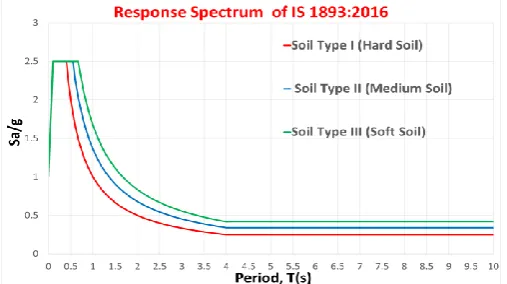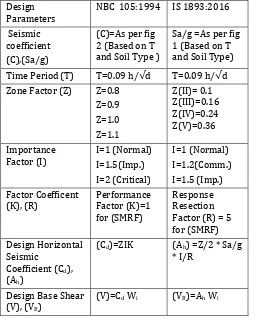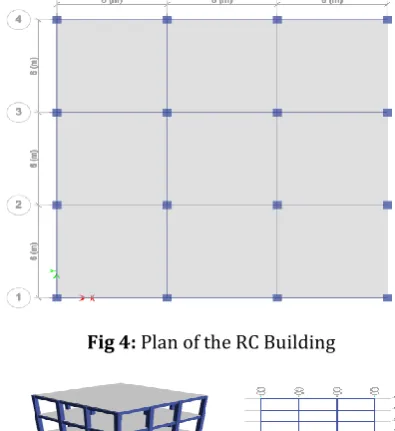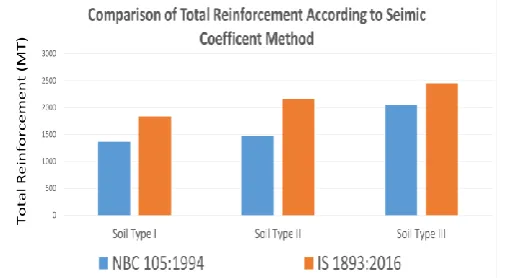© 2019, IRJET | Impact Factor value: 7.34 | ISO 9001:2008 Certified Journal | Page 1995
COMPARATIVE ANALYSIS OF NBC 105:1994 AND IS 1893:2016 SEISMIC
CODES WITH G+21 RC BUILDING.
Prateek Raj Pandit
1, Vasudev M V
21
Postgraduate Student, Department of Civil Engineering, NMIT, Karnataka, India
2
Associate Professor, Department of Civil Engineering, NMIT, Karnataka, India
---***---Abstract –
Nepal lies in a seismically active region and has
a long history of massive earthquakes. Therefore, after the 1988 A.D earthquake, Nepal published its own seismic design code NBC 105 in year 1994A.D. Nevertheless, a lot of designers in Nepal adopted IS code of standard for seismic analysis. In this paper, G+21 RC Frame building have been selected for different soil conditions for understanding better perspective of these two codes. In total nine models are analyzed and designed using ETABS 2016. The building performance and design results like displacement, base shear, and the total quantity of design reinforcement are selected for comparison. From the comparison result, it shows that IS code shows higher base shear, displacement for soil type I and II. In the case of soil type III, NBC shows higher base shear, inter story drift ratio and displacement than IS code. However, due to higher load factor critical load combinations of IS code shows higher reinforcement demand than NBC code.
Key Words
:
NBC 105:1994, IS 1893:2016, RC frame,
ETABS 2016, G+21 RC Frame.
1. INTRODUCTION
Nepal being in a seismically active region has a long history of destroying tremors. The concentration of epiceneter in Nepal and the Himalayan area is the subduction of the Indian plate underneath the Eurasian plate. The subduction of the Indian plate is at the rate of 40 cm/year [1], which causes pressure and stress concertation between plates. Therefore, Seismicity is high in this region, which is subjected to repeated and powerful past tremors. A couple of imperative tremors were in 1255, 1810, 1866, 1934, 1980, 1988 and the most recent was on 2015 A.D [2].
After seismic tremor in 1988 A.D., Department of Urban Development and Building Construction (DUDBC) introduce Nepal National Building Code (NBC) in 1994 AD. The implementation of the NBC code was established when the Ministry of Physical Planning and Works (MPPW) affirmed the Building Construction System Improvement Committee [3]. The seismic analysis of structures in Nepal relies upon NBC 105 (1994). Regardless, most of the current structures in Nepal are analyzed and designed based on the Indian standard code. This is in light of the fact that Nepalese codes require sufficient information to address the current design measures. Therefore, most of the building design exercises in Nepal rely upon Indian books, instructive modules, and codes. [4]
1.1 OBJECTIVE OF THIS PAPER
To understand the seismic analysis procedure involve in NBC 105:1994 and IS 1893:2016. To study the behavior of G+21 RC buildings for
different paprmeters like base shear, inter storey drift ratio, displacement, and total reinforcement required for various soil type considered in NBC and IS code.
To compare the analysis result of G+21 building according to NBC and IS code.
2. STUDY OF NBC 105:1994 and IS 1893-1:2016:
Every seismic code has its own set of analysisng parameters. NBC105:1994 was designed, based on probabilistic seismic hazard analysis with respect to 150 km boundary of Nepal and IS 1893:2016 had designed based on deterministic hazard analysis with respect to recorded time history data [3]. NBC 105:1994 is not recommended for analyzing unusual structure like the power plant, bridge, dames, and structures greater than 90m of height. However IS 1893:2016 has given different parts separated for analyzing critical structures. Therefore, for comparing the final analysis result, the two code has treated independently.
For seismic analysis, both codes have their own response spectrum curve as seen in figure 1 and 2. The spectra acceleration coefficient is determined by Sa/g for IS 1893:2016 and Basic seismic coefficient (C) for NBC 105:1994. The classifications of soil type considered for both of the codes are similar.
[image:1.595.308.562.594.736.2]© 2019, IRJET | Impact Factor value: 7.34 | ISO 9001:2008 Certified Journal | Page 1996
Fig 2: Response Spectrum curve according to NBC105:1994
[image:2.595.36.288.55.252.2]The design parameters required for calculating design horizontal acceleration of RC frame structure as per IS 1893:2016 and NBC 105:1994 has represented in table 1.
Table -1: Design Parameters required for Seismic Analysis of NBC 105:1994 and IS 1893:2016.
Design
Parameters NBC 105:1994 IS 1893:2016 Seismic
coefficient (C),(Sa/g)
(C)=As per fig 2 (Based on T and Soil Type )
Sa/g =As per fig 1 (Based on T and Soil Type) Time Period (T) T=0.09 h/√d T=0.09 h/√d Zone Factor (Z) Z=0.8
Z=0.9 Z=1.0 Z=1.1 Z(II)= 0.1 Z(III)=0.16 Z(IV)=0.24 Z(V)=0.36 Importance
Factor (I) I=1 (Normal) I=1.5(Imp.) I=2 (Critical)
I=1 (Normal) I=1.2(Comm.) I=1.5 (Imp.) Factor Coefficent
(K), (R) Performance Factor (K)=1 for (SMRF)
Response Resection Factor (R) = 5 for (SMRF) Design Horizontal
Seismic
Coefficient (Cd),
(Ah)
(Cd)=ZIK (Ah) =Z/2 * Sa/g
* I/R
Design Base Shear (V), (VB)
(V)=Cd Wi (VB)=Ah Wi
According to IS 1893:2016 and NBC 105:1994, India and Nepal has been divided into four different seismic zones. Nepal is considered as zone V based on the zone factor of India [3]. For the importance factor, NBC code has higher value than IS. According to NBC 105:1994, the importance factor for normal residential building (I=1), Public Buildings
(I=1.5) and critical buildings like structures for support acid, toxic, or petroleum distribution facilities (I=2). Where as, as per IS1893:2016 importance factor for normal residential building (I=1), for commercial with occupancy more than 200 (I=1.2) and for important and public buildings (I=1.5). The performance factor (K) and Response reduction factor (R) are defined based on the performance of the building. For example, if structures are non-ductile like masonry structure, then the performance factor (K) will increase and in contrary Response reduction factor (R) will decrease. Therefore, for buildings, which has a low capacity of resisting lateral load, the design horizontal seismic coefficient of that building will increase for both the codes. According to NBC and IS, the base shear (VB) is the design
horizontal coefficient multiplied by seismic weight of the building. Seismic weight is total dead plus an appropriate percentage live load of the building.
According to IS 1893:2016 the design lateral load at each floor (i) is determined by:
According to NBC 105:1994 the design lateral force is determined by:
Where Wi is seismic weight at the floor (i) and hi is floor
height.
The critical load combinations considered according to IS 1893:2016 and NBC 105:1994 are shown in table 2. For IS 1893:2016, the maximum load combination factor is 1.5 and for NBC 105:1994 the maximum load combination factor is 1.3.
Table -2: Design load combination according to NBC 105:1994 and IS 1893:2016.
NBC 105:1994 Load
Combination IS 1893:2016 Load Combination D.L+1.3L.L± (RSAx, EQx) 1.5 D.L
D.L+1.3L.L± (RSAy, EQy) 1.5 D.L + L.L
0.9 D.L ± 1.25(RSAx, EQx) 1.2(D.L+L.L± (RSAx, EQx)) 0.9 D.L ± 1.25(RSAy, EQy) 1.2(D.L+L.L± (RSAy, EQy))
[image:2.595.37.293.374.693.2] [image:2.595.309.560.579.731.2]© 2019, IRJET | Impact Factor value: 7.34 | ISO 9001:2008 Certified Journal | Page 1997
3. METHODOLOGY:
[image:3.595.328.526.161.377.2]In the present study, G+21 RC frame buildings are analyzed according to NBC 105:1994 and IS 1893:2016 for seismic coefficient method and response spectrum method. The building is symmetric in nature with no configuration irregularity. The plan considers of 3-bay of 6m center to center in both the directions. The building lies in Kathmandu Valley with zone factor (Z=1) according to NBC and (Z=V) according to IS.
Table -2: General classification of building
No. of Storey 22
Total Storey Height 88m Typical floor Height 4m
No. column 16
Height to width ratio of
building 4.88
Length to width ratio of
building 1
Column Size, Concrete 700 x 700 mm,M35 Beam Size, Concrete 400 x 500 mm,M25 Slab Size, Concrete 200mm, M25
Loads Live Load: 3kN/m2
Floor Finishes: 1.5 kN/m2
Importance Factor (I) 1.5 Type of Building SMRF Soil Type Consider I, II, III
Natural Time Period (T) 4.695 (ETABs)
The comparison of design seismic coefficient (Cd, Ah) of
SMRF frame with importance factor 1.5 and natural period of structure (T) adopted for repose spectrum analysis in ETABS is shown in figure 3.
Fig 3: Comparison of Design Seismic Coefficient According To NBC 105:1994 and IS 1893:2016
From figure 3 it shows the structures whose time-period is between 0.7-5 sec. and lies in soil type III, NBC 105:1994 gives higher design horizontal seismic coefficient than of IS 1893:2016.
Fig 4: Plan of the RC Building
Fig 5: 3D view of RC Building (Left) Elevation of Building (Right)
4. RESULT AND DISCUSSION:
According to Seismic Coefficient Method, for soil type I, the total base shear of IS 1893:2016 is 32.22% more than NBC 105:1994. For soil type II, the total base shear of IS 1893:2016 is 43.32% more than NBC 105:1994. However, in case of soil type III, the total base shear of IS 1893:2016 is 11.64% less than NBC 105:1994. The comparison of total base shear according to the seismic coefficient method of NBC 105:1994 and IS 1893:2016 is presented in figure 6.
[image:3.595.38.288.238.495.2] [image:3.595.36.288.561.730.2]© 2019, IRJET | Impact Factor value: 7.34 | ISO 9001:2008 Certified Journal | Page 1998
Fig 6: Comparison of Total Base Shear According To [image:4.595.36.290.269.411.2]Seismic Coefficient Method of NBC 105:1994 and IS 1893:2016
Fig 7: Comparison of Total Base Shear according to Response Spectrum Method of NBC 105:1994 and IS
1893:2016
According to Seismic Coefficient Method, for soil type I, the maximum displacement of IS 1893:2016 is 40.76% more than NBC 105:1994. For soil type II, the maximum displacement of IS 1893:2016 is 52.58% more than NBC 105:1994. However, in case of soil type III, the maximum displacement of IS 1893:2016 is 5.98% less than NBC 105:1994.
Fig 8: Comparison of Maximum Displacement According To Seismic Coefficient Method of NBC 105:1994 and IS
1893:2016
[image:4.595.312.560.534.682.2]According to the Model Response Spectrum Method, for soil type I, the maximum displacement of IS 1893:2016 is 31.94% more than NBC 105:1994. For soil type II, the maximum displacement of IS 1893:2016 is 43.33% more than NBC 105:1994. However, in case of soil type III, the maximum displacement of IS 1893:2016 is 11.25% less than NBC 105:1994.
Fig 9: Comparison of Maximum Displacement According to Response Spectrum Method of NBC 105:1994 and IS
1893:2016
The maximum inter sotrey drift ratio limit is 0.004 according to IS 1893:2016 and 0.01 according to NBC 105:1994. As per code perpespective non of the RC frame structure are beyond inter storey drift limit.
According to Seismic Coefficient Method, for soil type I, the maximum inter storey drift ratio of IS 1893:2016 is 29.95% more than NBC 105:1994. For soil type II, the maximum inter storey drift ratio of IS 1893:2016 is 40.91% more than NBC 105:1994. However, in case of soil type III, the maximum inter storey drift ratio of IS 1893:2016 is 13.19% less than NBC 105:1994.
Fig 10: Comparison of Maximum Inter storey Drift ratio According To Seismic Coefficient Method of NBC 105:1994
[image:4.595.38.288.562.702.2]© 2019, IRJET | Impact Factor value: 7.34 | ISO 9001:2008 Certified Journal | Page 1999
According to Model Response Spectrum Method, for soil type [image:5.595.309.561.127.254.2]I, the maximum inter storey drift ratio of IS 1893:2016 is 33.33% more than NBC 105:1994. For soil type II, the maximum inter storey drift ratio of IS 1893:2016 is 37.5% more than NBC 105:1994. However, in case of soil type III, the maximum inter storey drift ratio of IS 1893:2016 is 11.25% less than NBC 105:1994.
Fig 11: Comparison of Maximum Inter Storey Drift Ratio According to Response Spectrum Method of NBC 105:1994
and IS 1893:2016
The critical load combination factor is maximum in IS1893:2016 than NBC 105: 1994. Therefore, the total reinforcement demand is maximum in IS1893:2016 compared to the total reinforcement demand of NBC 105:1994. According to Seismic Coefficient Method, for soil type I, the maximum reinforcement demand of IS 1893:2016 is 34.57% more than NBC 105:1994. For soil type II, the maximum reinforcement demand of IS 1893:2016 is 46.48% more than NBC 105:1994. In addition, for soil type III, the maximum reinforcement demand of IS 1893:2016 is 19.16% more than NBC 105:1994.
Fig 12: Comparison of Total Reinforcement Demand According to Seismic Coefficient Method of NBC 105:1994
and IS 1893:2016
According to the Response Spectrum Method, for soil type I, the maximum reinforcement demand of IS 1893:2016 is 22.49% more than NBC 105:1994. For soil type II, the maximum reinforcement demand of IS 1893:2016 is 30.77% more than NBC 105:1994. In addition, for soil type III, the
[image:5.595.38.288.187.314.2]maximum reinforcement demand of IS 1893:2016 is 8.71% more than NBC 105:1994.
Fig 13: Comparison of Total Reinforcement Demand According to Response Spectrum Method of NBC 105:1994
and IS 1893:2016
5. CONCLUSIONS
From the comparative analysis of G+21 RC building for different soil category of NBC 105:1994 and IS1893:2016, the following conclusions are drawn:
For both NBC 105:1994 and IS 1893:2016, the seismic coefficient method shows higher base shear, displacement and reinforcement demand than the model response spectrum analysis.
For soil type I and II, IS1893:2016 gives higher base shear, displacement and drift than NBC 105:1994.
For soil type III NBC 105:1994 give higher base shear, displacement and drift than IS 1893:2016.
IS 1893:2016 gives higher reinforcement demand than NBC 105:1994.
REFERENCES
[1] Sjoerd Nienhuys Seismic Building Codes in the Himalaya
Region”, Issue May 2016, pp- 02-04
[2] Hemchandra Chaulagain, Dipendra Gautam and Hugo Rodrigues , Revisiting Major Historical Earthquakes in Nepal: Overview of 1833, 1934, 1980, 1988, 2011, and 2015 Seismic Events, Elsevier,2018
[3] Er. Pujan Neupane, Er. Samyog Shrestha, Comparative
Analysis of Seismic Codes of Nepal and India for RC Buildings (IJETT). ISSN 2231-5381, Vol.28
[4] Anup Shrestha, comparison between common seismic
[image:5.595.37.290.512.651.2]© 2019, IRJET | Impact Factor value: 7.34 | ISO 9001:2008 Certified Journal | Page 2000
STANDARD CODES
1. IS: 456-2000 - Code of Practice for Plain and Reinforced Concrete, Bureau of Indian Standards, New Delhi.
2. NBC 105:1994 – Seismic Design of Building In Nepal.
3. IS: 1893 (Part1)-2016 - Code of Practice for Criteria for Earthquake Resistant Design of Structures, Part 1: General Provisions and Buildings, Bureau of Indian Standards, New Delhi.
4. IS: 875-1987 - Code of Practice for Design Loads (other than Earthquake) for Buildings and Structures, Part 1: Dead Loads, Part 2: Imposed Loads, Part 5: Special Loads and Load Combinations, Bureau of Indian Standards, New Delhi.




